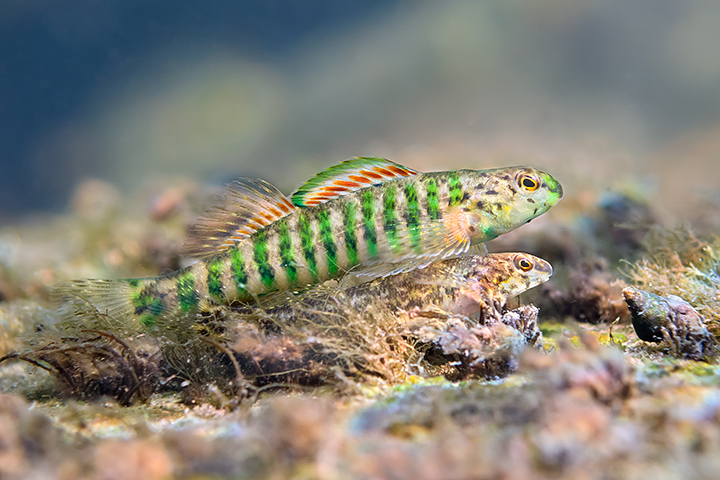Reproduction
Seasonal variation has occurred in clutch size (the number of eggs that are mature and ovulated), ovum size, or both in various species of Etheostoma. General reproductive trends for this species, are for clutch size to peak in the early to mid-season and for egg size to decrease with increasing water temperatures. The breeding seasons of Etheostoma zonale begin in late to early April, and continue through mid-to-late July. Studies have shown that Etheostoma zonale begin breeding when water temperatures are around 8-10°C and stop breeding when water temperatures are around 25°C each year(Barron and Albin, 2004).
Spawning takes place in shallow, moderate current water about 0.6-1.6m deep. Eggs attach to the algae that grows on surfaces of boulders under water. Most pairs court and spawn in a 1m² area. The males use their head, snout and/or fins to nudge and stimulate the nape and head regions of the female. The female will then bury into the algae and begin to undulate her caudal area from side to side. Very shortly after the female begins to undulate, the male will mount her and begin to quiver. After the spawning bout, (which lasts approximately one second), the male swims about 5-10cm away, while the female stays stationary. The male will then return to the female and begin courting again. This process will continue for about 30-60 minutes. On average, a female will lay 1-2 eggs per spawning bout. Bright and dull colored males have been seen to spawn successfully which indicates that courtship behavior may be more important than color to the female (Walters,1994).
Although there are many parts of reproduction in darters that are still unknown and cannot be factually explained, other studies have shown that the greatest clutch sizes occur in the middle of the breeding season for darters. Therefore, because the Etheostoma zonale species has a higher Gonadosomatic Index,(ratio of ovary mass to carcass mass), in the middle of their breeding season, (where the conditions for successful reproduction are best), females concentrate their greatest reproductive efforts at that time. Ultimately, seasonal and geographic variation are direct correlations with the reproductive success and life history in darter species (Barron and Albin, 2004). However, another study indicates that mechanical constraint, additive genetic variation, and spatial and temporal heterogeneity in the environment have played a role in the effects on the life history of the Etheostoma zonale species (Guill and Heins, 2000). These factors will become more clear once more life history studies have been done on darters.

